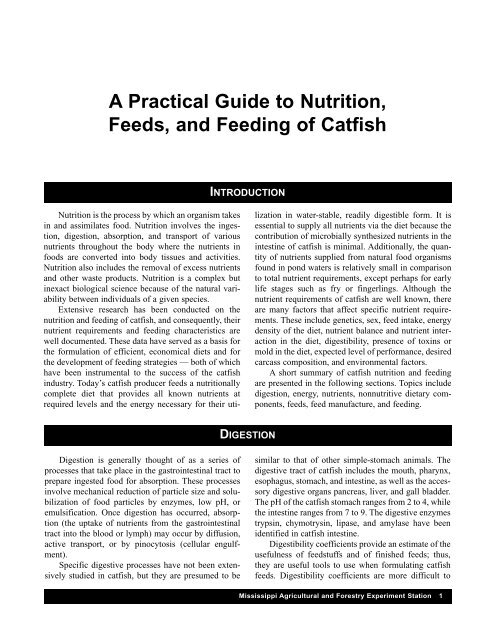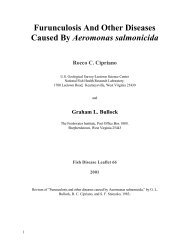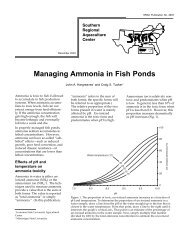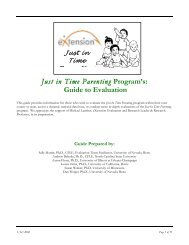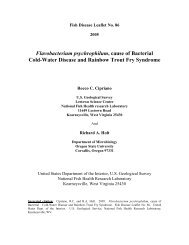A Practical Guide to Nutrition, Feeds, and ... - cop.eXtension.org
A Practical Guide to Nutrition, Feeds, and ... - cop.eXtension.org
A Practical Guide to Nutrition, Feeds, and ... - cop.eXtension.org
Create successful ePaper yourself
Turn your PDF publications into a flip-book with our unique Google optimized e-Paper software.
A <strong>Practical</strong> <strong>Guide</strong> <strong>to</strong> <strong>Nutrition</strong>,<br />
<strong>Feeds</strong>, <strong>and</strong> Feeding of Catfish<br />
<strong>Nutrition</strong> is the process by which an <strong>org</strong>anism takes<br />
in <strong>and</strong> assimilates food. <strong>Nutrition</strong> involves the ingestion,<br />
digestion, absorption, <strong>and</strong> transport of various<br />
nutrients throughout the body where the nutrients in<br />
foods are converted in<strong>to</strong> body tissues <strong>and</strong> activities.<br />
<strong>Nutrition</strong> also includes the removal of excess nutrients<br />
<strong>and</strong> other waste products. <strong>Nutrition</strong> is a complex but<br />
inexact biological science because of the natural variability<br />
between individuals of a given species.<br />
Extensive research has been conducted on the<br />
nutrition <strong>and</strong> feeding of catfish, <strong>and</strong> consequently, their<br />
nutrient requirements <strong>and</strong> feeding characteristics are<br />
well documented. These data have served as a basis for<br />
the formulation of efficient, economical diets <strong>and</strong> for<br />
the development of feeding strategies — both of which<br />
have been instrumental <strong>to</strong> the success of the catfish<br />
industry. Today’s catfish producer feeds a nutritionally<br />
complete diet that provides all known nutrients at<br />
required levels <strong>and</strong> the energy necessary for their uti-<br />
Digestion is generally thought of as a series of<br />
processes that take place in the gastrointestinal tract <strong>to</strong><br />
prepare ingested food for absorption. These processes<br />
involve mechanical reduction of particle size <strong>and</strong> solubilization<br />
of food particles by enzymes, low pH, or<br />
emulsification. Once digestion has occurred, absorption<br />
(the uptake of nutrients from the gastrointestinal<br />
tract in<strong>to</strong> the blood or lymph) may occur by diffusion,<br />
active transport, or by pinocy<strong>to</strong>sis (cellular engulfment).<br />
Specific digestive processes have not been extensively<br />
studied in catfish, but they are presumed <strong>to</strong> be<br />
INTRODUCTION<br />
DIGESTION<br />
lization in water-stable, readily digestible form. It is<br />
essential <strong>to</strong> supply all nutrients via the diet because the<br />
contribution of microbially synthesized nutrients in the<br />
intestine of catfish is minimal. Additionally, the quantity<br />
of nutrients supplied from natural food <strong>org</strong>anisms<br />
found in pond waters is relatively small in comparison<br />
<strong>to</strong> <strong>to</strong>tal nutrient requirements, except perhaps for early<br />
life stages such as fry or fingerlings. Although the<br />
nutrient requirements of catfish are well known, there<br />
are many fac<strong>to</strong>rs that affect specific nutrient requirements.<br />
These include genetics, sex, feed intake, energy<br />
density of the diet, nutrient balance <strong>and</strong> nutrient interaction<br />
in the diet, digestibility, presence of <strong>to</strong>xins or<br />
mold in the diet, expected level of performance, desired<br />
carcass composition, <strong>and</strong> environmental fac<strong>to</strong>rs.<br />
A short summary of catfish nutrition <strong>and</strong> feeding<br />
are presented in the following sections. Topics include<br />
digestion, energy, nutrients, nonnutritive dietary components,<br />
feeds, feed manufacture, <strong>and</strong> feeding.<br />
similar <strong>to</strong> that of other simple-s<strong>to</strong>mach animals. The<br />
digestive tract of catfish includes the mouth, pharynx,<br />
esophagus, s<strong>to</strong>mach, <strong>and</strong> intestine, as well as the accessory<br />
digestive <strong>org</strong>ans pancreas, liver, <strong>and</strong> gall bladder.<br />
The pH of the catfish s<strong>to</strong>mach ranges from 2 <strong>to</strong> 4, while<br />
the intestine ranges from 7 <strong>to</strong> 9. The digestive enzymes<br />
trypsin, chymotrysin, lipase, <strong>and</strong> amylase have been<br />
identified in catfish intestine.<br />
Digestibility coefficients provide an estimate of the<br />
usefulness of feedstuffs <strong>and</strong> of finished feeds; thus,<br />
they are useful <strong>to</strong>ols <strong>to</strong> use when formulating catfish<br />
feeds. Digestibility coefficients are more difficult <strong>to</strong><br />
Mississippi Agricultural <strong>and</strong> Forestry Experiment Station 1


